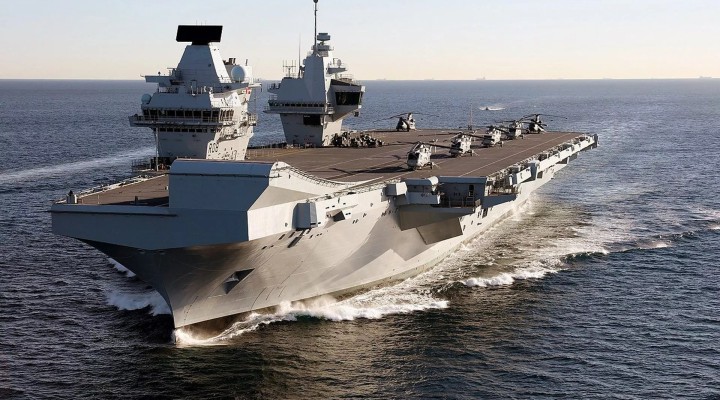HMS Queen Elizabeth’s Technical Woes Highlight ‘Systemic Problems’ in West’s Largest Weapon Programs

One of the United Kingdom’s two aircraft carriers made headlines last week after it failed to take part in NATO’s much-touted military exercise due to a technical malfunction.
Britain’s HMS Queen Elizabeth aircraft carrier is stuck in its dock for the immediate future after an issue with the vessel’s starboard propeller shaft was discovered by engineers.
The ship was due to take part in NATO’s Steadfast Defender military exercises launched mere days ago.
Having announced this development via X (formerly Twitter), the UK Royal Navy said that the carrier’s sister ship HMS Prince of Wales is going to set sail for Steadfast Defender “as soon as possible.”
Earlier, UK Armed Forces Minister James Heappey said that the Queen Elizabeth may be deployed to the Red Sea where the UK helps the United States wage a military campaign against the Houthis. It remains unclear, however, how this breakdown may affect London’s plans for the carrier.
Meanwhile, the Prince of Wales has its own history of rendering itself unfit for battle all on its own.
Only last year, the ship had to abort its voyage to the US, where it was supposed to engage in joint drills with US and Canadian warships after the carrier broke down near the Isle of Wight and had to be towed back to port.
As British media noted at the time, this breakdown occurred after the carrier had to delay its departure from the Portsmouth Naval Base in Hampshire due to a technical issue. Ironically, said issue reportedly involved the starboard propeller shaft as well.
The fact that the HMS Prince of Wales has been plagued by technical malfunctions practically since it entered service in 2019 raised concerns that the vessel may be cannibalized for parts for HMS Queen Elizabeth, though this did not happen to date.
While reports from 2023 claim that many Royal Navy ships quit the service, UK media revealed that two British warships were decommissioned and their crews reallocated to newer vessels amid what appears to be the lack of naval personnel this January.
Commenting on the current situation with HMS Queen Elizabeth, geopolitical analyst and former US Marine Brian Berletic told Sputnik that it is “just the latest incident in a long line of maintenance problems plaguing” both the carrier and its sister ship.
“Both carriers were built by the Aircraft Carrier Alliance comprised of several large and notoriously corrupt arms manufacturing corporations who do business through bribery and by maximizing profits at the expense of safety and quality,” Berletic said. “The fact that there are only two Queen Elizabeth class aircraft carriers in the world, and both have major propulsion issues, points to a systemic problem hardly unique among the collective West’s largest (and most expensive) weapons programs.”
According to him, the Queen Elizabeth class aircraft carrier program itself “reflects a disconnect between British ambitions and the means to pursue them.”
“In reality, the UK itself does not face any major military threats and because it possesses nuclear weapons, has no need for a large military force,” Berletic elaborated. “Yet because British special interests seek unwarranted power and influence abroad, including working alongside the United States to encroach upon Russia in Eastern Europe, interfere in the Middle East, and ‘containing’ China in the Asia-Pacific, they require disproportionately vast military capabilities the UK’s economy and industrial base are incapable of sustaining.”
He pointed out that the US-UK military operations in the Red Sea have failed to stem the Houthi missile attacks there, thus highlighting the fact that “the economic and technological disparity British, European, and American imperialism enjoyed for generations is over,” even though said fact is “unacknowledged by the collective West’s foreign policy circles.”
“The longer the UK pours resources into projecting power abroad, the more neglected economic and industrial fundamentals become at home, compounding the problem over time. Add to that the corruption and incompetence inherent in the collective West’s profit-driven political and economic system, not only will these types of problems continue, they will only multiply,” Berletic projected.
He added that, while the British Royal Navy should not be underestimated, “its capabilities will continue to decline well into the foreseeable future until British foreign policy finally fits the reality of the world the UK actually exists within, not the world it wishes it still existed in.”
For his part, Matthew Gordon-Banks, a former British Conservative member of parliament and senior research fellow at the UK Defence Academy, offered a different take on the matter, arguing that “the only thing wrong with the Royal Navy is that it is too small in size with a secondary issue of insufficient crew to man the existing ships.”
Though the United Kingdom has “extremely professional” armed forces, Gordon-Banks said, “there have been significant reductions in numbers and equipment” in the last 25 years “following the ‘peace dividend’ after the collapse of the Berlin Wall.”
“The current recruitment crisis may be a combination of poor terms and conditions of service together with younger people knowing that politicians have sent personnel to fight unnecessary and sometimes illegal conflicts such as in Iraq,” he suggested.
Regarding the current situation in the Red Sea, Gordon-Banks said that “the US is the leader and primary combatant for the West” there.
“Whilst it is unlikely more UK ships will be sent to the region, the UK may still take part in long-range air strikes on minority groups,” he added.
 TheAltWorld
TheAltWorld 
0 thoughts on “HMS Queen Elizabeth’s Technical Woes Highlight ‘Systemic Problems’ in West’s Largest Weapon Programs”